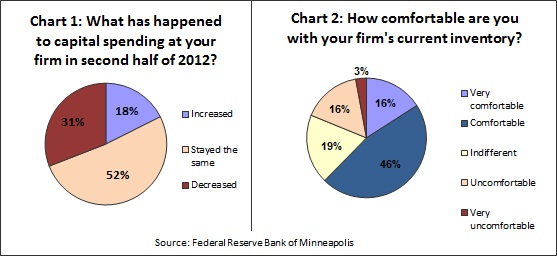January is a time for economic forecasts for the coming year, and the Minneapolis Fed has already released its 2013 regional outlook, along with its business poll and manufacturers survey. These surveys showed that respondents generally expect more of the same; they have a moderate outlook for the growth of sales and hiring at their firms.
A separate ad hoc poll, conducted by the Minneapolis Fed about the same time as the above polls, provides further support for this modest outlook for 2013. The survey asked firms about capital expenditure plans and inventory levels, which are closely tied to firms’ expectations.Responses from 72 businesses, from a variety of industry sectors, showed an outlook mostly consistent with the Minneapolis Fed’s forecast.
More than half of respondents reported that their capital spending stayed the same in the second half of 2012 (see Chart 1), which is about what one might expect with continued growth. However, more firms reported decreases in capital spending than increases. The majority of firms reported that capital expenditures were primarily for replacement and maintenance of existing equipment. But more than 40 percent of respondents said that most or some of their capital spending was going toward expanding capacity.

Among firms that said they were expanding capacity, the most common reason given was improved sales prospects, cited by just over a quarter of all the firms surveyed, followed by 19 percent who said current capacity was stretched too thin. Another 11 percent of firms also reported that their current equipment is not well suited to their future needs.
Slightly more than a quarter of firms surveyed reported that they were cutting capacity. Of those, about half cited reduced sales prospects. Current excess capacity and increased costs were each blamed by just over a third of firms trimming capacity.
Respondents appeared more optimistic about inventory levels (see Chart 2). Nearly two-thirds of all firms surveyed reported being comfortable or very comfortable with current inventory levels. The survey asked if there were signs of excessive inventories due to sluggish demand, and 80 percent reported no sign. Further, most district firms seem optimistic about their future demand prospects. More than half reported that they were optimistic or somewhat optimistic that they may be ready to build inventories; only 9 percent said they were pessimistic.
One final positive note: This survey was conducted late in 2012, before the resolution of the “fiscal cliff.” At the time, nearly two-thirds of respondents said uncertainty about the future was curtailing current capital spending, and more than half specifically cited the state of demand in the face of fiscal contraction as a source of uncertainty. With at least temporary resolution of that uncertainty, for better or for worse, the outlook may have brightened. Maybe.
Joe Mahon is a Minneapolis Fed regional outreach director. Joe’s primary responsibilities involve tracking several sectors of the Ninth District economy, including agriculture, manufacturing, energy, and mining.





